Ancient Egypt has long been of great fascination to the world, capturing the imaginations of everyone from the Greeks who conquered Egypt in 332 BC, all the way to people of our own time. Much of the ancient civilization’s culture is preserved in the monumental temples and pyramids, the cryptic hieroglyphics, and of course in the elaborate burials and mummifications that became the hallmark of Egypt. While the interest in Ancient Egypt continues on, it was perhaps at its most fervent in the Victorian era. Discoveries such as the Rosetta Stone by the French in 1799 made it possible for scholars to finally translate the hieroglyphics that had stumped them for centuries, and created an intense interest in this formerly mysterious culture.
It was with Napoleon’s invasion of Egypt and the discovery of the Rosetta Stone that the discipline of Egyptology was born. The publication of the essay Description de l’Égypte (1809-1829) officially made the study an academic discipline. Soon, historians, archaeologists, and anthropologists alike flocked to Egypt to excavate the tombs and study what was inscribed on the walls of its temples and other landmarks. Many of these excavations yielded crypts of pharaohs richly adorned with gold, jewels, and mummies, many of which were taken back to Europe to be put on display in museums. The people of the Victorian age came in droves to see these mummies, which both delighted and terrified them. There were even mummy unwrapping parties, which guests could attend and watch as the linen wrappings were peeled back to reveal the embalmed body inside. When Poe was fourteen, there was even a mummy on public display in the Senate Chamber of the Capitol in Richmond.

An Invitation to a Mummy Unwrapping Party
Poe wrote a satirical critique of this fascination with mummies entitled “Some Words With a Mummy” (published in 1845). The story is a commentary on the treatment of the artifacts of Ancient Egypt, particularly the mummies. Once back in Europe, many mummies were damaged or destroyed in the name of science by dissections and examinations, and others were stolen from their tombs by grave robbers to be ground into a powder which was thought to have medicinal properties. Poe’s mummy, Allamistakeo, admonishes his examiners on their treatment of him, showing the author’s view on the Egypt Mania and the disrespect of the tombs that had overtaken the Victorian era.
At the same time as the publication of “Some Words With a Mummy”, the Egyptian Building was being constructed to house the Medical College of Virginia here in Richmond. Designed by architect Thomas W. Stewart, the building is in the Egyptian Revival style and brings to mind the colossal temples that dot the Nile Valley. The choice to make the building very Egyptian in appearance may coincide with the Egypt Mania of the time, or perhaps ally the medical campus with Imhotep, the Egyptian priest who is thought to have been the first physician. The building became a national landmark in 1969, and is a treasured part of the MCV campus today. It has been in continual use since 1845, and houses an auditorium and classrooms.

The MCV Egyptian Building

 > Donate
> Donate
1 Comment
Ah! I absolutely can never get enguoh of Egyptian history and culture! That is so cool you have a museum full of stuff right there for you to look at and experience. The Egyptians (like others from many societies) were an important people. Your pictures are neat, and I love the flowers, too pretty especially when some of us in colder states won’t see them for a while yet!! Thanks for posting, your blog is always so interesting!